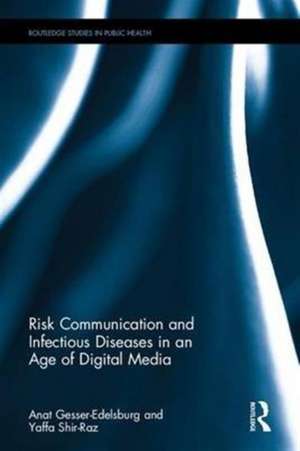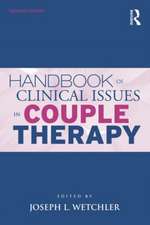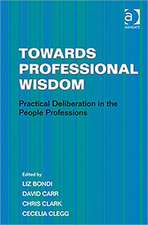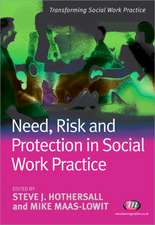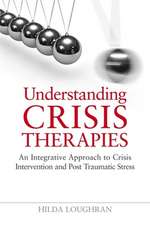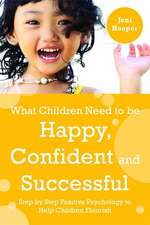Risk Communication and Infectious Diseases in an Age of Digital Media: Routledge Studies in Public Health
Autor Anat Gesser-Edelsburg, Yaffa Shir-Razen Limba Engleză Hardback – 10 noi 2016
Following the shift in the role of the public from recipients to a vocal entity, this book explores the different organizational strategies for communicating public health information and identifies common misconceptions that can inhibit effective communication with the public. Drawing on original research and a range of global case studies, this timely volume offers an important assessment of the complex dynamics at play in managing risk and informing public health decisions.
Providing thought-provoking analysis of the implications for future health communication policy and practice, this book is primarily suitable for academics and graduate students interested in understanding how public health communication has changed. It may also be useful to health care professionals.
Din seria Routledge Studies in Public Health
-
 Preț: 303.87 lei
Preț: 303.87 lei -
 Preț: 310.36 lei
Preț: 310.36 lei - 5%
 Preț: 422.97 lei
Preț: 422.97 lei - 5%
 Preț: 439.40 lei
Preț: 439.40 lei - 5%
 Preț: 429.02 lei
Preț: 429.02 lei - 5%
 Preț: 452.96 lei
Preț: 452.96 lei - 5%
 Preț: 433.00 lei
Preț: 433.00 lei -
 Preț: 402.66 lei
Preț: 402.66 lei -
 Preț: 389.39 lei
Preț: 389.39 lei - 17%
 Preț: 278.34 lei
Preț: 278.34 lei - 5%
 Preț: 300.26 lei
Preț: 300.26 lei - 21%
 Preț: 239.40 lei
Preț: 239.40 lei - 5%
 Preț: 366.45 lei
Preț: 366.45 lei - 5%
 Preț: 371.01 lei
Preț: 371.01 lei - 5%
 Preț: 357.29 lei
Preț: 357.29 lei -
 Preț: 373.07 lei
Preț: 373.07 lei -
 Preț: 379.76 lei
Preț: 379.76 lei -
 Preț: 367.46 lei
Preț: 367.46 lei -
 Preț: 370.14 lei
Preț: 370.14 lei -
 Preț: 373.87 lei
Preț: 373.87 lei - 28%
 Preț: 242.66 lei
Preț: 242.66 lei - 28%
 Preț: 240.90 lei
Preț: 240.90 lei
Preț: 1162.08 lei
Preț vechi: 1417.16 lei
-18% Nou
Puncte Express: 1743
Preț estimativ în valută:
222.36€ • 232.16$ • 184.03£
222.36€ • 232.16$ • 184.03£
Carte tipărită la comandă
Livrare economică 04-18 aprilie
Preluare comenzi: 021 569.72.76
Specificații
ISBN-13: 9781138186064
ISBN-10: 1138186066
Pagini: 198
Ilustrații: 1
Dimensiuni: 156 x 234 x 18 mm
Greutate: 0.41 kg
Ediția:1
Editura: Taylor & Francis
Colecția Routledge
Seria Routledge Studies in Public Health
Locul publicării:Oxford, United Kingdom
ISBN-10: 1138186066
Pagini: 198
Ilustrații: 1
Dimensiuni: 156 x 234 x 18 mm
Greutate: 0.41 kg
Ediția:1
Editura: Taylor & Francis
Colecția Routledge
Seria Routledge Studies in Public Health
Locul publicării:Oxford, United Kingdom
Cuprins
Introduction: The Transformation of Emerging Infectious Disease Communication in the New Media Age Chapter 1. The Public Sphere and Health Communication in the Context of Emergent Infectious Diseases Chapter 2. The Challenge of Digital Media for Health Organizations Chapter 3. Organizational Policy and Practice Chapter 4. Strategies for Communicating Health Information and Risk Chapter 5. The Role of Medical Experts and Health Journalists Chapter 6. The Public's Understanding and Decision Making Regarding Science and Risk Chapter 7. Observations and Lessons: Managing Health Risks in the Age of Digital Media
Recenzii
Whether the outbreak is one of Ebola, or Zika, or another infectious agent, health authorities scramble to communicate with their diverse publics about elements of risk, decisional choices, and actions required. With the advent of real-time digital media platforms, social media outlets, and ubiquitous mobile devices, the public dynamically participates in the co-creation of what constitutes risk, for whom, with what consequence, and requiring what action. This co-creation is a complex, dynamic, and emergent process, and this book provides invaluable insights, among many, into how "wisdom of the crowd" can be harnessed in ways that can spell the difference between life and death. A must read for those interested in the interface of infectious disease, communicating risk, and the potential and pitfalls of social media.
Arvind Singhal, Ph.D. is the Marston Endowed Professor of Communication at the University of Texas at El Paso and appointed Professor 2 at Hedmark University of Applied Sciences, Norway.
Ground-breaking - if only this work had been available, understood and applied in early 2014 at the beginning of the West African Ebola epidemic both the human toll in lives lost and the excesses of the following Fearbola events could have been significantly curtailed. In such outbreaks when vaccines and effective counter-measures are not yet available, effective communication is our strongest asset and by drawing on the combined informed input of the "public" we can better insure optimization of these public health interventions. This work should be required reading for medical and media professionals alike.
James J. James, M.D., is the Executive Director of the Society for Disaster Medicine and Public Health and Adjunct Professor at the University of Georgia
The authors take a controversial position on controversies regarding scientific evidence, namely, that lay skepticism about scientists’ claims is not always indefensible. Paying particular attention to the role of new media, the authors take a broad perspective in asking how the public and the experts can achieve warranted mutual respect, recognizing the commonalities and conflicts in their interests. The authors pursue that question vigorously, drawing broadly on academic research from social science and the humanities, illustrated with engaging historical and topical examples
Baruch Fischhoff, Howard Heinz University Professor, Carnegie Mellon University
The essence of this book is splendidly embedded in its title, which suggests, with a subtle play of words, that new media are modifying 'communication' of infectious diseases. Infectious diseases are indeed communicable in two senses, because they can be transmitted and because they are spoken. The authors wisely introduce the reader into metaphors surrounding infectious diseases and the way in which new media are shaping them. This is a great, fascinating, book, which raises critical questions about health risk communication and helps us re-think many current, obsolete, standards
Emilio Mordini, Responsible Technology, France; chair of the Risk Communication working party of the Collaborative management platform for detection and analyses of re- emerging and foodborne outbreaks in Europe (COMPARE)
Arvind Singhal, Ph.D. is the Marston Endowed Professor of Communication at the University of Texas at El Paso and appointed Professor 2 at Hedmark University of Applied Sciences, Norway.
Ground-breaking - if only this work had been available, understood and applied in early 2014 at the beginning of the West African Ebola epidemic both the human toll in lives lost and the excesses of the following Fearbola events could have been significantly curtailed. In such outbreaks when vaccines and effective counter-measures are not yet available, effective communication is our strongest asset and by drawing on the combined informed input of the "public" we can better insure optimization of these public health interventions. This work should be required reading for medical and media professionals alike.
James J. James, M.D., is the Executive Director of the Society for Disaster Medicine and Public Health and Adjunct Professor at the University of Georgia
The authors take a controversial position on controversies regarding scientific evidence, namely, that lay skepticism about scientists’ claims is not always indefensible. Paying particular attention to the role of new media, the authors take a broad perspective in asking how the public and the experts can achieve warranted mutual respect, recognizing the commonalities and conflicts in their interests. The authors pursue that question vigorously, drawing broadly on academic research from social science and the humanities, illustrated with engaging historical and topical examples
Baruch Fischhoff, Howard Heinz University Professor, Carnegie Mellon University
The essence of this book is splendidly embedded in its title, which suggests, with a subtle play of words, that new media are modifying 'communication' of infectious diseases. Infectious diseases are indeed communicable in two senses, because they can be transmitted and because they are spoken. The authors wisely introduce the reader into metaphors surrounding infectious diseases and the way in which new media are shaping them. This is a great, fascinating, book, which raises critical questions about health risk communication and helps us re-think many current, obsolete, standards
Emilio Mordini, Responsible Technology, France; chair of the Risk Communication working party of the Collaborative management platform for detection and analyses of re- emerging and foodborne outbreaks in Europe (COMPARE)
Descriere
In a digital world in which lay people have an increasingly strong voice in the public sphere, how can health organisations best exert influence to contain the outbreak and spread of infectious diseases? This book considers the challenges facing public health experts in communicating information effectively to their intended audiences in order to avert the risk of epidemic crises. Drawing on a range of global case studies, including Ebola, H1N1, SARS and HIV/AIDS, the authors examine the complex dynamics at play in digital media in relation to risk perception, scientific expertise and lay scepticism. They assess the implications for health communication policy and practice.
